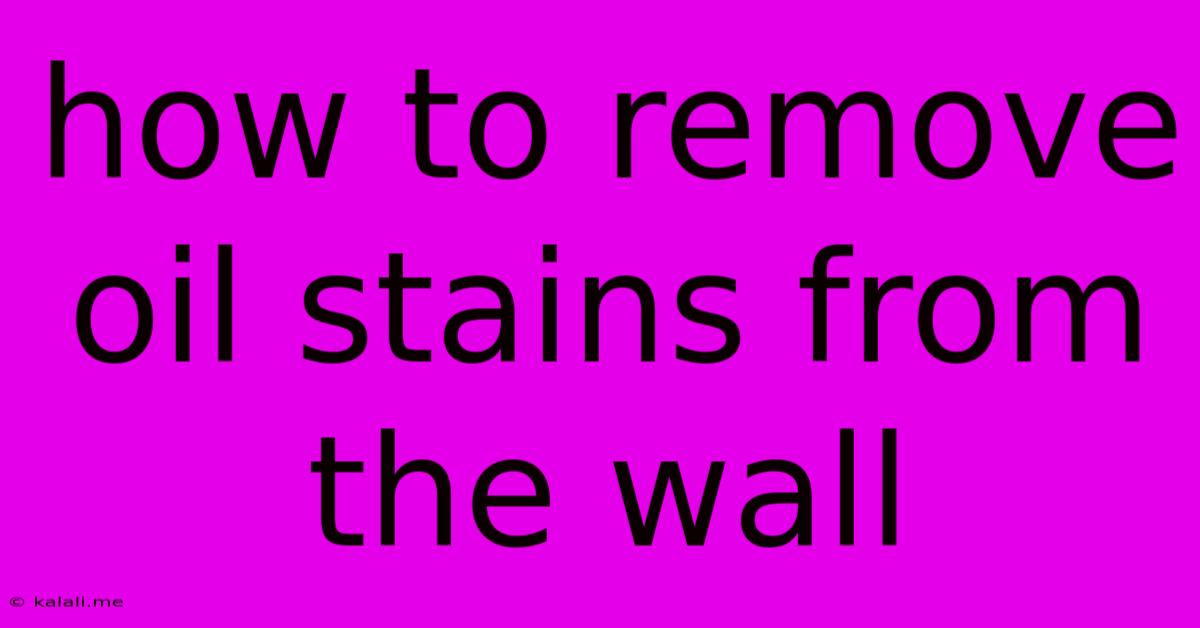How To Remove Oil Stains From The Wall
Kalali
May 20, 2025 · 4 min read

Table of Contents
How to Remove Oil Stains from Your Wall: A Comprehensive Guide
Oil stains on your walls can be a real eyesore, but don't despair! This comprehensive guide provides various methods to effectively remove those pesky marks, leaving your walls looking pristine. From tackling fresh spills to dealing with stubborn, set-in stains, we've got you covered. This article covers everything from identifying the type of paint to choosing the right cleaning solution, ensuring you achieve the best results without damaging your walls.
Understanding the Enemy: Types of Oil and Paint
Before diving into the cleaning process, it's crucial to identify the type of oil stain and the type of paint on your wall. Different oils (vegetable oil, motor oil, etc.) and paints (latex, oil-based) react differently to cleaning agents. Knowing this will help you choose the most effective and safest cleaning method. For example, using harsh chemicals on a delicate paint finish could damage the wall, leading to more problems than you started with.
Tackling Fresh Oil Stains: The Quickest Solution
Fresh oil stains are much easier to remove than those that have had time to set. The key here is speed!
- Immediate Action: As soon as the spill occurs, blot (don't rub!) the stain with a clean cloth or paper towel to absorb as much oil as possible. Rubbing will only spread the stain and make it harder to remove.
- Gentle Cleaning: Once the majority of the oil is absorbed, gently wipe the area with a mild dish soap solution. Mix a small amount of dish soap with warm water, dip a clean cloth into the solution, wring it out well, and gently clean the affected area. Rinse with clean water and blot dry.
Removing Set-In Oil Stains: A Step-by-Step Approach
Set-in oil stains require a more thorough approach. Here's a step-by-step guide:
-
Test in an Inconspicuous Area: Before applying any cleaning solution to the visible stain, always test it in an inconspicuous area of the wall to ensure it doesn't damage the paint or cause discoloration.
-
Baking Soda Paste: For less stubborn stains, create a paste of baking soda and water. Apply the paste to the stain, letting it sit for about 30 minutes to absorb the oil. Gently scrub with a soft brush or sponge, then wipe clean with a damp cloth.
-
Dish Soap and Water (for Latex Paint): For latex painted walls, a stronger solution of dish soap and water can be effective. Apply the solution to the stain, let it sit for a few minutes, then gently scrub with a soft brush. Rinse thoroughly and blot dry.
-
TSP (for Tough Stains & Oil-Based Paint): For particularly stubborn stains, or if you have oil-based paint, Trisodium Phosphate (TSP) can be a powerful cleaning agent. Always follow the manufacturer's instructions carefully and ensure proper ventilation. TSP is a strong cleaner, so use caution and protective gear like gloves. After cleaning with TSP, rinse thoroughly with clean water.
-
Commercial Cleaners: As a last resort, consider using a commercial cleaning product specifically designed for oil stain removal. Again, test it in an inconspicuous area first. Follow the manufacturer's instructions diligently.
Prevention is Key: Protecting Your Walls
Preventing oil stains in the first place is always the best approach. Here are some preventative measures:
- Careful Handling: Be mindful when handling oily substances near your walls.
- Protective Covering: Use drop cloths or plastic sheeting when working with oily materials.
- Regular Cleaning: Regularly cleaning your walls can prevent stains from setting in.
Choosing the Right Tools
Selecting the right cleaning tools is essential for effective stain removal without causing damage. Here's what you should have on hand:
- Soft Cloths: Microfiber cloths are ideal for gentle cleaning and absorption.
- Soft Brushes: A soft-bristled brush can help gently scrub away stubborn stains.
- Sponges: Sponges can be useful for applying cleaning solutions and scrubbing.
- Paper Towels: Paper towels are great for blotting up fresh spills.
By following these steps and choosing the appropriate method based on the type of stain and paint, you can successfully remove oil stains from your walls, restoring their beauty and leaving your home looking its best. Remember, patience and a gentle approach are key to success!
Latest Posts
Latest Posts
-
Will Sand Help My Soggy Lawn
May 20, 2025
-
Can A King Take A Queen
May 20, 2025
-
Appears To Be In A Sentence
May 20, 2025
-
Can I Change My Signature Uk
May 20, 2025
-
Why Check Engine Oil When Warm
May 20, 2025
Related Post
Thank you for visiting our website which covers about How To Remove Oil Stains From The Wall . We hope the information provided has been useful to you. Feel free to contact us if you have any questions or need further assistance. See you next time and don't miss to bookmark.